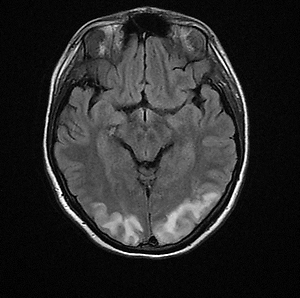Online first
About the Journal
Current issue
Archive
Publication Ethics
Anti-Plagiarism system
Instructions for Authors
Instructions for Reviewers
Editorial Office
Editorial Board
Contact
Reviewers
All Reviewers
2025
2024
2023
2022
2021
2020
2019
2018
2017
2016
General Data Protection Regulation (RODO)
CASE REPORT
Posterior reversible encephalopathy syndrome – Case report
1
Chair and Department of Neurology, Medical University of Lublin, Poland
2
Chair and Department of Human Anatomy, Medical University of Lublin, Poland
3
Faculty of Medicine, University of Concepción, Chile
4
Chair and Department of Rehabilitation and Orthopaedics, Medical University of Lublin, Poland
5
Department of Radiography, Medical University of Lublin, Poland
Corresponding author
J Pre Clin Clin Res. 2020;14(4):123-125
KEYWORDS
TOPICS
ABSTRACT
Introduction:
Posterior reversible encephalopathy syndrome (PRES) is a group of clinical disorders typically manifested by the presence of seizures, headache, impaired consciousness, nausea and focal neurological deficits. It is stated that PRES is a result of high blood pressure which leads to impaired self-regulation and hyperperfusion causing endothelial damage and vasogenic oedema or that excessive arteriolar vasoconstriction causes reduced blood flow, thus causing ischemia and cytotoxic oedema.
Case Report:
A 21-year-old woman was admitted to obstetrics & gynaecology department with symptoms of eclampsia. CT of the head revelaed a holohemispheric watershed pattern. MRI confirmed the presence of vasogenicoedema in the affected regions, typical for PRES. C-section was performed. Ten days after administering treatment, MRI showed complete withdrawal of the lesions. The diagnosis of PRES was based on clinical symptoms and MRI, with typical cortical and subcortical oedema without infarction.
Posterior reversible encephalopathy syndrome (PRES) is a group of clinical disorders typically manifested by the presence of seizures, headache, impaired consciousness, nausea and focal neurological deficits. It is stated that PRES is a result of high blood pressure which leads to impaired self-regulation and hyperperfusion causing endothelial damage and vasogenic oedema or that excessive arteriolar vasoconstriction causes reduced blood flow, thus causing ischemia and cytotoxic oedema.
Case Report:
A 21-year-old woman was admitted to obstetrics & gynaecology department with symptoms of eclampsia. CT of the head revelaed a holohemispheric watershed pattern. MRI confirmed the presence of vasogenicoedema in the affected regions, typical for PRES. C-section was performed. Ten days after administering treatment, MRI showed complete withdrawal of the lesions. The diagnosis of PRES was based on clinical symptoms and MRI, with typical cortical and subcortical oedema without infarction.
Kulczyński W, Kuroska G, Sapko K, Marciniec M, Muñoz-Niklitschek E, Dyndor P, Dyndor K. Posterior reversible encephalopathy syndrome – Case report. J Pre-Clin Clin Res. 2020; 14(4): 123–125. doi: 10.26444/jpccr/128702
REFERENCES (10)
1.
Hobson EV, Craven I, Blank SC. Posterior reversible encephalopathy syndrome: a truly treatable neurologic illness. Perit Dial Int. 2012; 32(6): 590–4. https://doi.org/10.3747/pdi.20....
2.
Fischer M, Schmutzhard E. Posterior reversible encephalopathy syndrome. J Neurol. 2017; 264(8): 1608–1616. https://dx.doi.org/10.1007%2Fs....
3.
Li K, Yang Y, Guo D, et al. Clinical and MRI Features of Posterior Reversible Encephalopathy Syndrome With Atypical Regions: A Descriptive Study With a Large Sample Size. Front Neurol. 2020; 11: 194. https://dx.doi.org/10.3389%2Ff....
4.
Parikh NS, Schweitzer AD, Young RJ, et al. Corticosteroid therapy and severity of vasogenic edema in posterior reversible encephalopathy syndrome. J Neurol Sci. 2017; 380: 11–15. https://doi.org/10.1016/j.jns.....
5.
Sudulagunta SR, Sodalagunta MB, Kumbhat M, et al. Posterior reversible encephalopathy syndrome(PRES). Oxf Med Case Reports. 2017; 2017(4): omx011. https://doi.org/10.1093/omcr/o....
6.
Kalaiselvan MS, Renuka MK, Arunkumar AS. Clinical Features and Outcomes of Patients with Posterior Reversible Encephalopathy Syndrome. Indian J Crit Care Med. 2017; 21(7): 453–456. https://doi.org/10.4103/ijccm.....
7.
Hinduja A. Posterior Reversible Encephalopathy Syndrome: Clinical Features and Outcome. Front Neurol. 2020; 11: 71. https://doi.org/10.3389/fneur.....
8.
Lamy C, Oppenheim C, Mas JL. Posterior reversible encephalopathy syndrome. Handb Clin Neurol. 2014; 121: 1687–701. https://doi.org/10.1016/b978-0....
9.
Okamoto K, Motohashi K, Fujiwara H, et al. PRES: Posterior Reversible Encephalopathy Syndrome. Brain Nerve. 2017; 69(2): 129–141. https://doi.org/10.11477/mf.14....
10.
Cordelli DM, Masetti R, Ricci E, et al. Life-threatening complications of posterior reversible encephalopathy syndrome in children. Eur J Paediatr Neurol. 2014; 18(5): 632–40. https://doi.org/10.1016/j.ejpn....
We process personal data collected when visiting the website. The function of obtaining information about users and their behavior is carried out by voluntarily entered information in forms and saving cookies in end devices. Data, including cookies, are used to provide services, improve the user experience and to analyze the traffic in accordance with the Privacy policy. Data are also collected and processed by Google Analytics tool (more).
You can change cookies settings in your browser. Restricted use of cookies in the browser configuration may affect some functionalities of the website.
You can change cookies settings in your browser. Restricted use of cookies in the browser configuration may affect some functionalities of the website.


